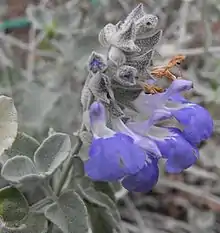Salvia cedrosensis
Salvia cedrosensis is an evergreen fruticose perennial plant that is endemic to the western (Pacific) coast of Baja California in Mexico, growing on the Vizcaino peninsula and Cedros Island.
| Salvia cedrosensis | |
|---|---|
 | |
| Scientific classification | |
| Kingdom: | Plantae |
| Clade: | Tracheophytes |
| Clade: | Angiosperms |
| Clade: | Eudicots |
| Clade: | Asterids |
| Order: | Lamiales |
| Family: | Lamiaceae |
| Genus: | Salvia |
| Species: | S. cedrosensis |
| Binomial name | |
| Salvia cedrosensis | |
It is found growing along dry riverbeds and canyons in rocky soil. In the wild it grows 60 cm (24 in) tall and wide, with small felt-like leaves that are whitish-grey and 2.5 cm (0.98 in). The flowers are violet-blue, with a pearly grey calyx and light violet around the edges.[1]
Notes
- Clebsch, Betsy; Barner, Carol D. (2003). The New Book of Salvias. Timber Press. p. 68. ISBN 978-0-88192-560-9.
This article is issued from Wikipedia. The text is licensed under Creative Commons - Attribution - Sharealike. Additional terms may apply for the media files.